
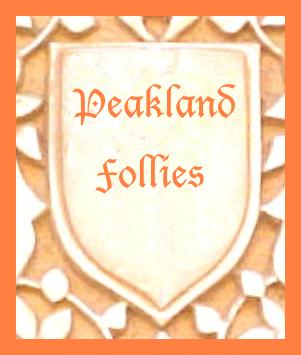


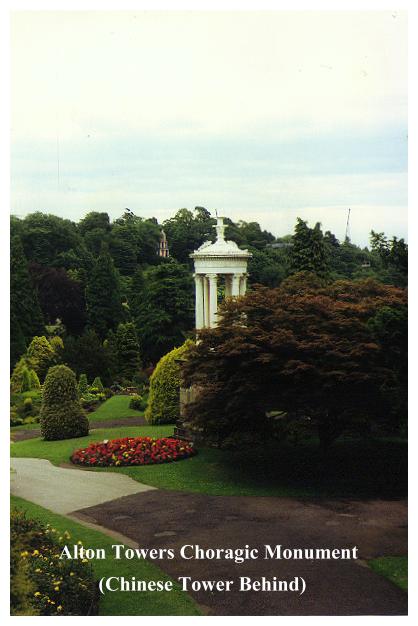
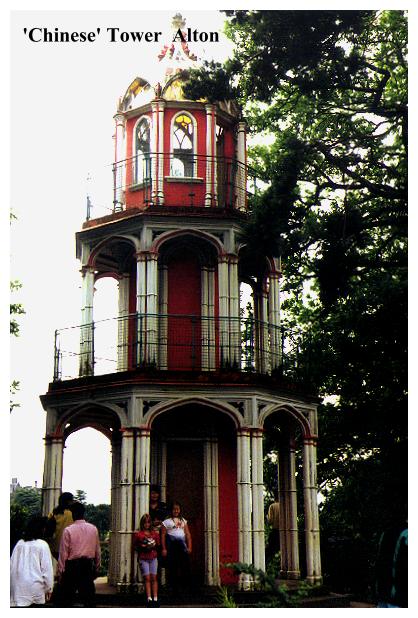
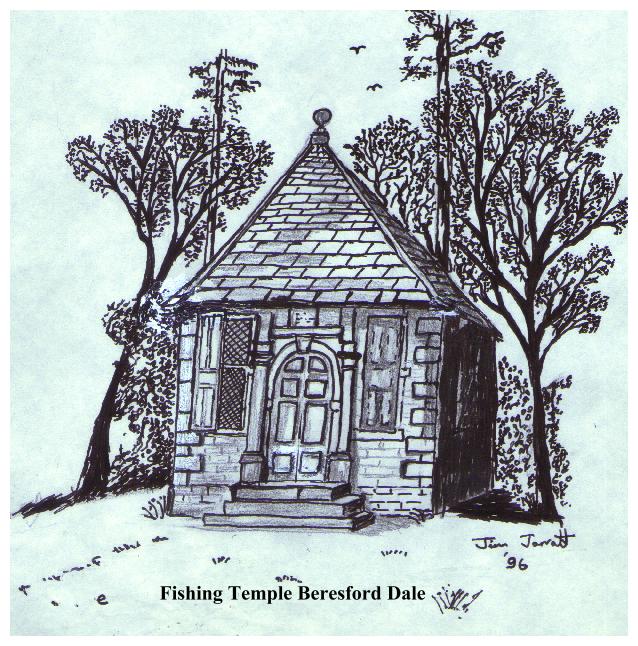
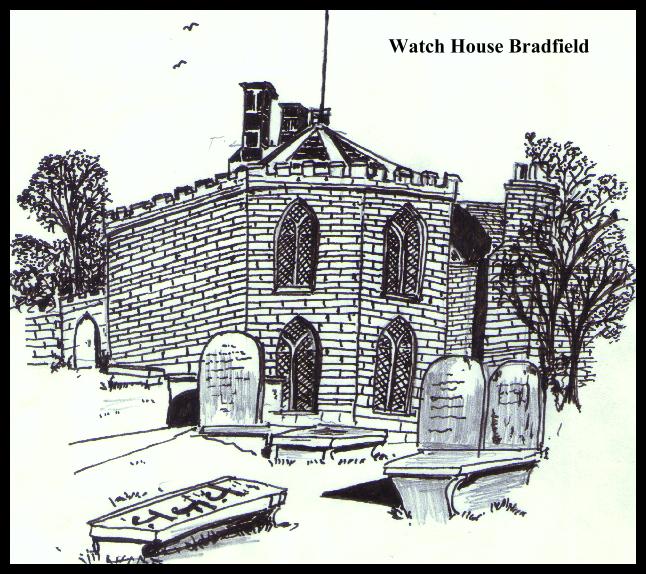
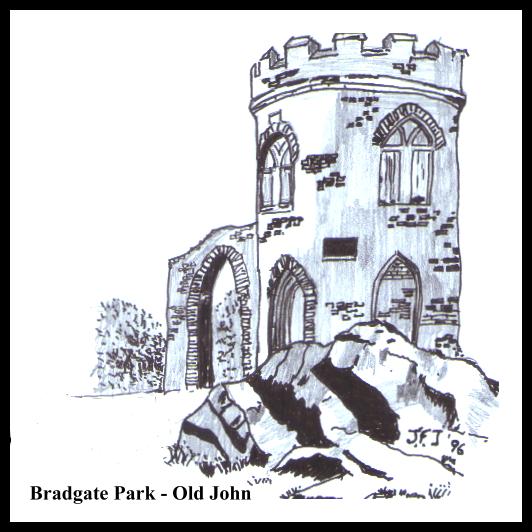
Although slightly beyond the pale of the area covered in this book, 'Old John' is nevertheless worth a mention because it is a fine example of the 'arch and tower' sort of folly encountered at Mow Cop. It was erected in 1786 by the fifth Earl of Stamford, in memory of a miller who once had his mill on the site (a six hundred foot high hilltop - the highest point in the park). The story goes that the earls' eldest son was celebrating his 21st birthday, and a bonfire had been lit on the hill to mark the event. The fire unfortunately had been constructed around a flagpole, which fell when it had burnt through, and killed the poor old miller who happened to be in the way! The tower was named after the miller and was, like many such structures, used for rest and refreshment by hunting parties and the like. On the wall of the tower a plaque refers to Charles Bennion who purchased Bradgate Park in 1928 and presented it to the City of Leicester for public recreational use.
Chatsworth, The Gardens
- SK 263 703. (Entrance) Peak District White Peak.
Despite the hefty admission charge, the Chatsworth gardens are well worth exploration, being well endowed with rockeries, canals, cascades, fountains and a number of interesting 'folly type' buildings. The first of these is the Cascade House, which stands at the top of 'The Great Cascade', a huge staircase with water running down it which reduced it (in the words of Horace Walpole) to 'no use at all!'. The Cascade House, when the fountains are in play is a sight to behold as waters froth and bubble down its domed and leaded roof.
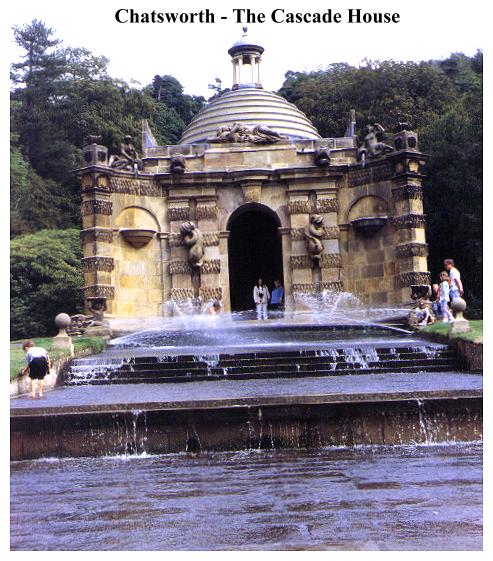
Just beyond the Great Cascade, surrounded by 'grotto' rocks and artificially placed crags and boulders is the Willow Fountain, a weeping willow which on closer inspection reveals itself to be a metal 'tree' which 'weeps' jets of water! Beyond the maze which stands on the site of Joseph Paxton's Great Conservatory, (demolished in 1920, after its contents died during the Great War) lies Grotto Pond and the Chatsworth Grotto. This was built towards the end of the eighteenth century under the supervision of the Duchess Georgiana. It originally housed a mineralogical collection belonging to White Watson, a local geologist.
The grotto is crowned with a round, rustic hut. Descending the Ravine and the Azalea Dell we finally reach the far end of the great canal leading to the South Front of the house. This long pond contains the famous Emperor Fountain. In 1826 the Duke of Devonshire went on a mission to Russia to visit the Czar (The trip cost him £50,00 of his own money - a fabulous sum in those days!). In the gardens of the Imperial Palace at Peterhof Czar Nicholas showed him a fountain which he claimed could throw the highest jet in the world. The Duke thereupon determined that he would have a fountain at Chatsworth which would outdo this, and also that he would have it ready for the Czar's return visit to England.
The Duke dug out the two Emperor Lakes in rapid time, and the fountain was quickly completed; but alas, though the Duke met the Czar in London, he never came to Chatsworth, so the whole scheme failed in its primary object - to impress an Emperor!
Leaving the house and ascending to the northeast of the garden we find a small Moorish Summer House. It carries two plaques- one of which somewhat optimistically reads:-
Won from the brow of yonder headlong hill,
Through grassy channels, see, the sparkling rill
O'er the chafed pebbles, in its murmering flow
Sheds freshness on the thirsty valley below,
Quickening the ground till trees of every zone
In Chatsworth's soil. and clime, forget their own.
H.L. sept. MDCCCXXXIX
Cheddleton - Nr. Leek.
The Bathhouse. Sham Castle built in 1841. Reputed to have underground passages and chambers!
Chesterfield - The Crooked Spire.
Hardly a folly, but most definitely a curiosity, Chesterfields fourteenth century Parish Church with its famous 238 ft high 'Crooked Spire' has long been a landmark to travellers everywhere. Various stories are extant as to how the spire got that way:- The best known explanation tells us how one wild and stormy night the Devil sat himself down on the steeple, and had to twist his tail around it to prevent himself from being blown away. Suddenly he heard a Chesterfield woman actually tell the truth, and this so surprised him, that he sped away at great speed. But he'd forgot to untwist his tail, so as result the steeple got bent! There are of course seemingly limitless variations on this story. One account has the Old Nick kicking the spire in agony after having been badly shoed by a local blacksmith; and in another the Devil sneezes after catching a whiff of incense from the church below! While sitting with his tail round the steeple he caused the twist by bowing to a virtuous bride entering the church - or alternatively he jerked round in surprise because the bride was actually a virgin!
Another old wives tale says the problem was caused by excessive bellringing! The steeple actually leans almost eight feet out of plumb, and the more prosaic explanation for the 'twist' is that the spire was never cross braced, too much green timber was used, and the structure was simply warped under the weight of the 32 tons of lead tiles bearing down on it.
Codnor Park, Ripley - Jessop Column.
MAP REF:
A tall (and ruinous) Doric column on a plinth. This belvedere, containing a now unsafe spiral staircase, was built in 1815 as a monument to William Jessop, engineer and founder of the Butterley Ironworks.
Cratcliffe Hermitage
- MAP REF:SK 227 623 White Peak 1:25000
Hidden up in Cratcliffe Tors, not far from Birchover is a tiny hermitage - a rock shelter shaded and hidden by an ancient yew, among a jumble of steep boulders. A sturdy iron fence bars access to the interior, which seems odd, considering that the whole cave is less than six feet in depth. Only when your eyes adjust to the gloom can you see the reason for the security. Carved on the right hand wall is a magnificent mediaeval sculpture of Christ crucified beside a niche that probably once held a small lamp. The carving is believed to be of fourteenth century date, and the place was probaly the refuge of hermits, who when not engaged in their solitary devotions perhaps helped passing travellers, as the trackway which passes twixt here and Robin Hood's Stride is the Portway, once a busy highway across the moors, but now frequented only by ramblers and rock climbers. Nearby, in a field beyond the crag top are the remains of a fine stone circle.
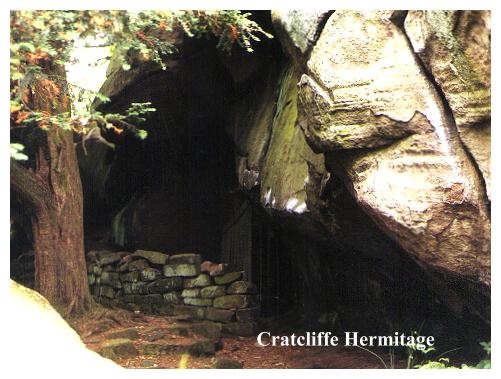
Derwent Reservoir
- MAP REF: SK 173 898. Peak District Tourist 1"
Tip's Memorial, by the dam wall of Derwent Reservoir bears the following inscription:-
IN
COMMEMORATION OF
THE DEVOTION OF
TIP
THE SHEEPDOG WHICH STAYED
BY THE BODY OF HER DEAD
MASTER, MR.JOSEPH TAGG,
ON THE HOWDEN MOORS FOR
FIFTEEN WEEKS FROM 12TH
DECEMBER 1953 TO 27th
MARCH 1954v
The poor emaciated dog was nursed back to health, and was presented with a bronze medal for her devotion, but died a year later in 1955 as a result of her ordeal. She was buried on the moors where they found her master. The stone was paid for by subscriptions srom all over the world.
Ecton - Manifold Valley.
MAP REF:097 584 Peak District. The White Peak. 1:25 00.
'The Hillocks' This unusual private house, which sports a miniature sham shurch tower complete with spire, was built by Mr. Arthur Ratcliff, who was the tory M.P. for Leek, in 1933. the copper spire was obtained from a demolished chapel. Mr. Ratcliff's parliamentary record was an appalling catalogue of non-attendance at crucial debates. No doubt he was too busy planning follies!
Elvaston Castle - The Moorish Temple.
Elvaston Castle, now the heart of a country park run by the local council is a tranquil yet popular place. The house is essentially a 19th century gothic structure built around (and incorporating the fabric of) a much older Elizabethan House. It was built by the eccentric Earl of Harrington, who owned a snuffbox for each day of the year, refused to appear in daylight, and spent a fortune on litigation and temperance reform. In his grounds and gardens (he employed 90 gardeners) he planned various conceits. The style he employed was somewhat unique:- chinese, moorish and gothic all rolled into one! Elvaston Castle's ornate wrought iron gates were 'aquired' from a palace in Madrid! There is some fine grotto and rockery work on the far side of the lake, but Elvaston's real (and alas dilapidated) jewel lies at the end of the gardens on the other side of the house. The Moorish Temple is a bizarre structure. Large windowed and bulbous, it is topped by a curved baldachin, and can"t make up its mind whether its an arab's tent or a chinese pagoda! It is, (surprisingly, considering the lovely garden setting) in a sad and vandalised state. It will need a lot spending on it to save it, and one suspects that the council suffers from either a lack of interest or a lack of funds. It is sad. Such a magnificent folly as this should not be allowed to fall into ruin, especially in a public park where it could be given a function (refreshments perhaps?) and be enjoyed by all.
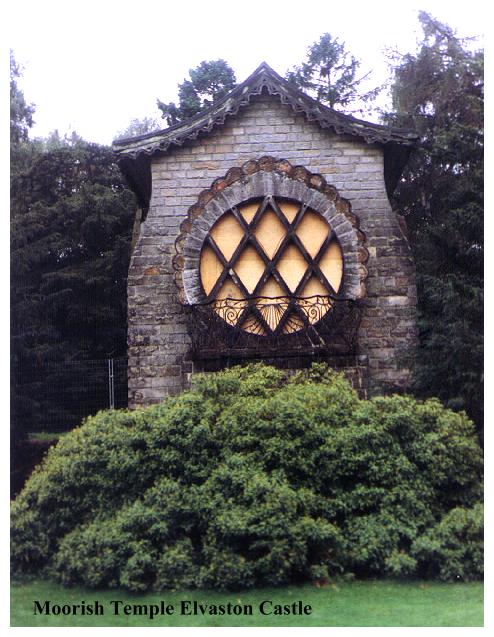
Eyam - (pronounced 'eem')
No follies as such but various interesting curiosities and monuments associated with the great plague that visited the village in 1665. The plague was introduced from London, brought in a bundle of rags it is said. Its effect on the little community of Eyam was devastating. Best known monuments to the Eyam Plague are the Riley Graves and Mompesson's Well.
Hartcliff Tower near Langsett
- SE 225 019. Peak District Tourist. 1"(See also Langsett Valve Tower)
Small, roughstone tower on the hillside between Langsett and Penistone. Origin and purpose uncertain. On private land.
Hathersage - Little John's Grave
. MAP REF: SK 235 818. Peak District Tourist. 1"
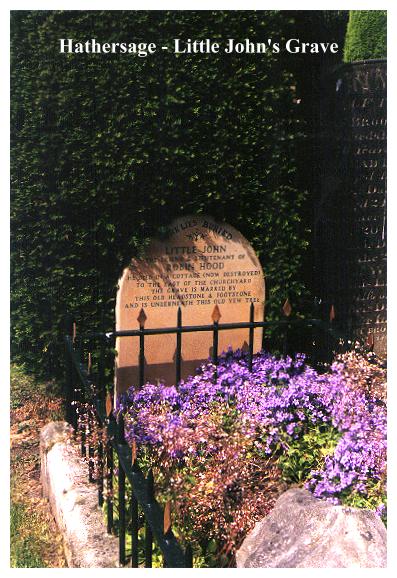
A stiff ascent up to St Michaels Church leads to a large grave beneath a yew in the southwest corner of the churchyard, where lies buried Hathersages' most famous son - Little John. Acording to legend, the great outlaw, in the fashion of his master at Kirklees Priory, is said to have loosed an arrow with the wish of being interred at the spot where it landed. Of course whether or not Little John is actually buried here or no is a matter of debate. A house, which stood on the eastern side of the church until the mid nineteenth century, was said to be the cottage in which little John died. In 1847 it was the residence of an old woman named Jenny Shard, and the story had been passed down through her family for generations. She remembered how in the eighteenth century the grave was opened by Captain James Shuttleworth, when the 32" femur of a giant was discovered! This would suggest a man seven feet in height! Other authorities maintain that a 600 year old gravestone in the church porch may well have been the original slab marking the resting place of Little John. It is also true that there was once a cap and longbow kept in the church which was said to have belonged to the famous outlaw these have since disappeared. Little John is said to have been a nailmaker in Hathersage, living in a cottage adjacent to the church.The grave is still looked after by the Ancient Order of Foresters.
The adjacent church is also of great interest, containing some fine brasses to the Eyre family, which were almost certainly the source of Charlotte Bronte's Jane Eyre. Charlotte's friend, Miss Ellen Nussey, was the sister of the Revd, Henry Nussey, the Vicar, and Charlotte is known to have stayed at Hathersage Vicarage in 1845.
Hopton- Near Matlock.
Gell's Tower. A windowless tower with two doors attached 6to a crinkle creankle wall. Built by Sir Philip Gell in 1790.
Ilam
- (pronounce 'eye'lam!).Octagonal Tower.SK 135 508. Peak District. White Peak 1:25 000.
This stands by the drive to Ilam Hall and I can discover little about it. The hall itself was rebuilt 1821-6 in the gothic style by Jesse Watts Russell, being based on designs by architect John Shaw (the elder). It was, in its day, a formidable pile with battlements and turrets, but today little survives to tell of its former glories. In a small grotto above the cliff is Congreve's Grotto. On the table and stone bench therein William Congreve is reputed to have written The Old Batchelour at the tender age of 18! Also at Ilam are distinctively styled estate houses and an 'Eleanor Cross' in memory of the first Mrs Watts Russell.
Ilkeston- The House of Cinders.
Cinder House is built from cindered clay, burnt a rusty brown. Its walls are thirty inches in thickness and due to the porosity of the material the house is cool in summer and warm in winter. It was built in 1833 by Francis Newdigate as an experiment in new building materials.
King's Newton - Village Cross.
The carved stone on the village cross, probably unique in England, is a case of commemorate in haste, repent at leisure, for it records the ascent to the throne of King Edward VIII on 20th January, 1936! Three hundred and twenty five days later King Edward abdicated so he could marry Mrs Simpson and the doughty inhabitants of King's Newton must have been left with egg on their faces!
Langsett Reservoir - The valve tower.
MAP REF: SE 213 005. Peak District Tourist. 1".
The crenellated top of this severely functional building is in point of fact a miniature replica of John of Gaunts Tower at Lancaster Castle. Why this should be so is not clear! Also the nearby reservoir keeper's house is similarly crenellated,
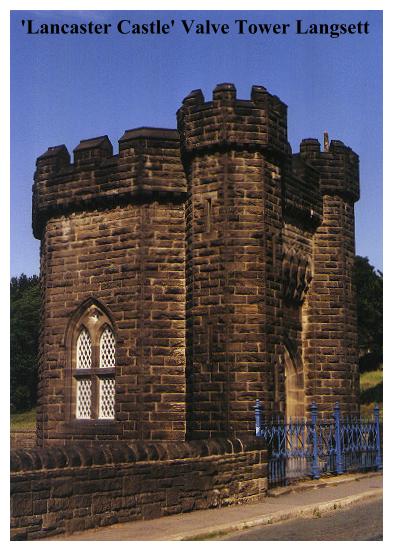
Lyme Park- Near Disley, Cheshire.
MAP REF. Landranger Sheet 109. 965 825 .
National Trust, managed & financed by Stockport MBC.
The ancestral seat of the Legh Family, partially Elizabethan, but largely altered in the 18th century by Giacomo Leoni and Lewis Wyatt. Lyme Park features an excellent country park, with countryside centre, pitch & putt, orienteering course, deer park and all the usual amenites. Pleasant walking may be enjoyed here, but the substantial admission charge to the park for motorists relegates it to the appendix! Lyme Park's folly is 'The Cage' a hunting enclosure with four towers and a central square block with balustrading, offering a prospect over the park. The cage dates from the 16th century but substantial alterations were made by Leoni in 1726. It has been used as a lockup, and as a Shepherd's House. Also in Lantern Wood, 'The Lantern', part of the original 16th century house, taken down by Samuel Wyatt and re-erected in the wood. Three storeyed with pyramid roof and archway running through the base.
Melbourne - The Birdcage Pergola.
This multicoloured, ornate, wrought iron summer house stands in the grounds of Melbourne Hall. It dates from around 1706 and is the work of Robert Bakewell, who created much wrought ironwork in and around Derbyshire. The 'Birdcage' however, is undoubtedly his finest work, and was such an elaborate undertaking that Bakewell required advance payment for his work!
Milford Chevin Tower.
On the Chevin above Milford, a short distance down the Derwent valley from Crich, stands this curious ruined tower. Obscure in origin and purpose, the adjacent railway tunnel ventilation shaft offers a clue to why it was built. In 1839, when the tunnel was being driven below,the tower was erected as a lookout, so there could be liason bewtween the two gangs of navvies digging the tunnel from either side of the hill. Originally it contained four floors and two fireplaces. Its exceptionally solid base suggests that it may once have housed machinery involved in sinking the airshaft. A similar structure stands above the Standedge Tunnel which carries the Manchester/Huddersfield line beneath the High Pennines.
Mugginton - The Halter Devil Chapel.
Adjacent to a cottage at Hulland Ward Intakes near Mugginton stands the tiny Halter Devil Chapel. A stone (now lost) once recorded that:
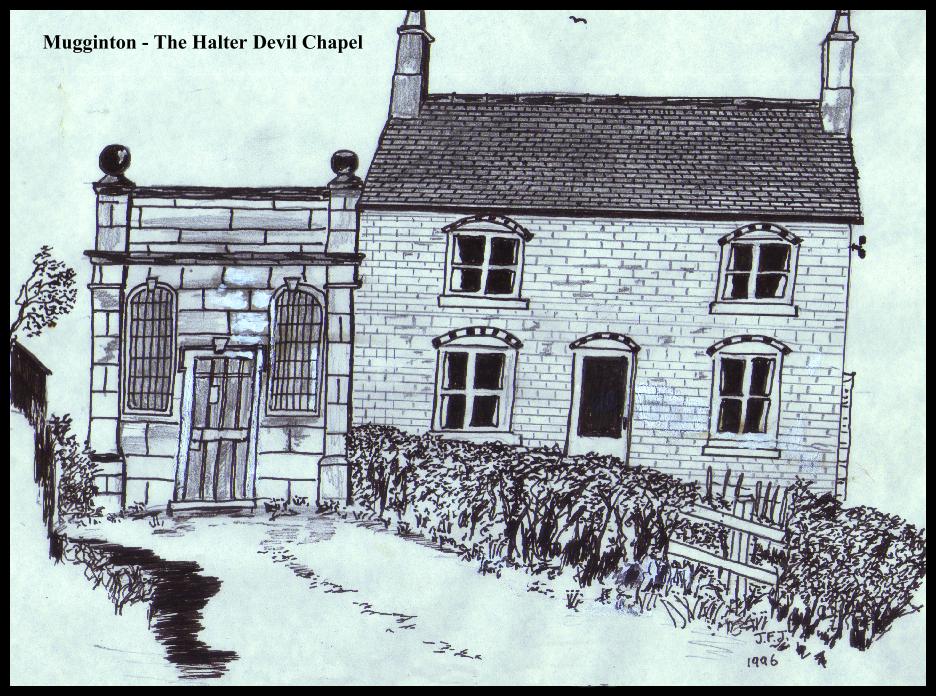
Francis Brown in his old age,
Thereby hangs (of course!) a tale! On a dark and stormy night in 1723, stubborn local farmer Francis Brown was of a mind to ride to Derby. Unfortunately he was in the sort of condition that in this day and age would would invite a request to 'blow into this bag, sir!' Despite his wifes attempts to dissuade him from this foolish errand, old Brown yelled at her shouting 'ride I will, even if I have to halter the devil himself!' Thereupon he went out to the paddock and came back, with what he thought was his horse. He struggled vainly in his attempts to put a halter over its head, until a sudden flash of lighting revealed that the animal had horns! Of course it may have been not so much the Devil as a case of mad cow disease, but be that as it may, so convinced was Farmer Brown that he had had an encounter with Satan himself, he thereafter lived a pious and sober existence, building this tiny chapel with its strange title, next to his house. The chapel is only fourteen by thirteen feet, and was never consecrated, but an afternoon service is still held here on the last Sunday in each month.
Did build him here a hermitage,
Who being old and full of evil
Once on a time haltered the Devil
Osmaston Park - Belvedere.
MAP REF: SK 206 432 Landranger Sheet 128 Derby & Burton-upon-Trent. On the A515 near Ashbourne.
Osmaston House was demolished in 1966. Its kitchen garden is now occupied by the Osmaston Garden Centre. the house was built for local industrialist Francis Wright in 1849. Wright, a man who liked to be different to his neighbours, employed the architect A. J. Stevens to design him a house with no chimneys. The house was heated by hot air ducts in the manner of the Roman hypocaust, the used air being ejected through a single chimney, built above the house in the kitchen garden. Unfortunately for this system to work, the chimney had to be at least 150 feet high. This did not deter Mr. Wright, who built a staircase around it, and converted it into a prospect tower, in the manner of Wainhouse Tower near Halifax. It seems that the square, italianiate chimney-cum-belvedere, did not serve its original function effectively however, for Osmaston House we learn was built with chimneys!
Peckforton Castle
- nr. Beeston Cheshire.
This mock mediaeval castle stands on a sandstone bluff overlooking the Cheshire Plain, not far from its neieghbour the rather more genuine (and ruinous) Beeston Castle, which dates from around 1220. Peckforton Castle was built 1844-50 by Anthony Salvin for the first Lord Tollemache. During World War II the castle was used as a school, then remained empty for many years. Part of it is now a private residence. It is occasionally open to the public. Peckforton also has an impressive mock mediaval Castle Lodge. A good circular walk may be had by way of Beeston Castle. (Where there is a car park)
Quarndon- North of Derby.
The Castellated Bath-house. This small gothic building was erected over the newly discovered chalybeate spring which was going to make Quarndon's fortune as a spa. Unfortunately a small earth tremor caused the spring to dry up, so the building became a useless white elephant!
Renishaw - Sitwell Curiosities.
The Sitwells of Renishaw were a weird family to say the least. Sir George Sitwell, father of the literary giants Osbert, Sacheverell and Dame Edith Sitwell, inherited the estate at the age of two. He fancied himself as an inventor, a landscape designer, a scholar and an antiquarian. His ideas included a musical toothbrush that played Annie Laurie, a revolver adapted for zapping wasps, and improving the appearance of his parkland by stencilling Chinese blue willow patterns on the rumps of his white cattle! A prolific writer, his treatises and boxes of notes included such exotic titles as Leper's Squints , Acorns as an Article of Mediaeval Diet, Sweet Preserves in the Fourteenth Century, the History of the Fork, Rotherham in the Dark Ages, The Beauty of dress at the time of the Black Death and Eckington Dump!
Sir George brought in 4,000 unemployed workers from Scarborough to landscape his estate, and planned numerous follies, though few of them were actually constructed. A ruinous aviary, described as a 'Gothic Temple' still exists, and, (although not confirmed by this author) the 'Arch in the Ravine' also. A fine sketch of this latter by John Piper appears in The Scarlet Tree, the second volume of Osbert's autobiography.
Osbert wrote at length about his father's eccentricities, for example his choice of Osbert's Prep school on the grounds that its headmaster was "The most famous dribbler in England". This had bewildered young Osbert, who was "quite unaware of its place as a technical term in the vocabulary of Association Football", remarking that dribbling had never been considered 'a meritorious accomplishment at home."!
His mother it seems, liked the school because "the headmaster's sister seemed so fond of flowers"!
The house itself was enlarged and heavily gothicised between 1793 and 1808 by Joseph Badger, a local architect, and was considered to be 'a folly' long before Sir George took possession. The Stable Block at Renishaw has recently been opened as a Sitwell Museum, with displays telling the story of this most bizarre family.
Stafford Castle
Staffords original (mediaeval) Castle stood on the banks of the River Sow. This was built by Ralph De Stafford, who obtained his licence to crenellate it in 1348. It was an rectangular block with four polygonal corner towers, but in 1643 it was demolished, and the ruin we see today was in fact constructed around 1817 by Sir George Jerningham, (later Lord Stafford). It was intended to be a Gothick mansion, but, despite its large being made habitable, only two of its towers were completed. Today much of it has been demolished and only its ground floor shell remains.
Staunton Harold Reservoir
nr. Melbourne. Windmill/Prospect Tower.
Perhaps the modernest folly in England. Here a ruined windmill has been made into a lookout tower for the new Staunton Harold Reservoir! It is accessible by car and a large carpark stands nearby.
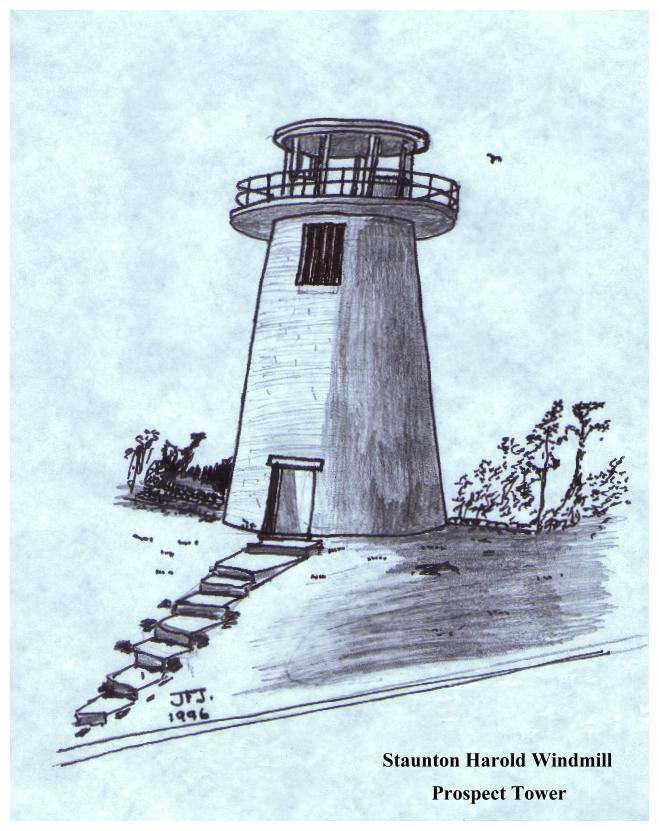
Sudbury Hall
- MAP REF SK 159 321 Landranger 128. Derby & Burton Upon Trent.
The Deerhouse- This beautiful sham fortress is in actual fact no such thing! It was in fact, built in 1723 as a deercote. Its roof originally had domes, and in the mid eighteenth century it was thatched. Its transformation into 'sham castle' probably occurred in the early nineteenth century. The deerpark in which it stands was originally created by Mistress Mary Vernon in 1614. Her Steward, Hardstaffe waxed lyrical about it:-
The old Blackmore (enlarged with some more ground,
Was with a strong High Pale encompaste round.
The purpose was, as shortly did appeare,
To make a parke for red and fallow deere.............
Sydnope Stand
- OUTDOOR LEISURE 24 SK298 635.
Built as a castellated eyecatcher for Sydnope Hall, it actually is an ornate facade behind which lurks a little stone cottage. It dates from 1865.
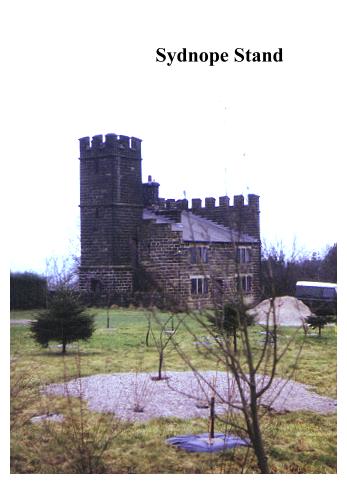
Tatton Park - Cheshire
Various follies. The Sheep Stealer's Tower. Another Choragic Monument (see Shugborough and Alton Towers) built by William Cole III of Chester (1820). Also a Japanese Garden and Shinto Temple.
Tideswell
MAP REF: SK 149 761. White Peak 1:25000
In Brook Bottom Valley north of Tideswell is a curious pointed cone. It is actually the cover of a well which once supplied water to the village. But what motivated why the odd shape?
Tixall Gatehouse
This magnificent gatehouse, standing just to the north of Shugborough Park was built around 1575 for Sir Walter Aston, the main point of access to a mansion that no longer exists. Certainly it must be the most ambitious Tudor gatehouse in this part of England. Sampson Erdeswick, writing in 1598 called it 'one of the finest pieces of work made of late times that I have seen in all these countries'. Just along the road, slightly to the north east, stands the Bottle Lodge. This is octagonal with an ogee roof and looks contemporary with the gatehouse. It is in a poor state. Tixall village also contains an Obelisk and an eighteenth century Rotunda, the latter being a refugee from nearby Ingestre House.
Trentham Park Staffs.
Trentham Park was an italianate mansion built in 1832 - 42 by Sir Charles Barry for the second Duke of Sutherland. It was, in fact, the 'role model' for Prince Albert's Osborne House on the Isle of Wight. It once had a fine tower which is now in the grounds of Sandon Park. The bulk of the house was demolished in 1910 and today the estate is a leisure park with funfair, camping, go karts and waterski-ing. The fine italian gardens however, remain, along with a number of interesting monuments. About a mile south of the house stands a Monument, which was erected to the first Duke in 1836. It is a plain column toppped by a colossal bronze statue. Trentham's real jewel however, is its Mausoleum which stands opposite the main gates. It was built 1807-1808, and is built in a massive and severe style, which, we are told, was inspired by the Boul—e - Ledoux period of radical French architecture. The architect was Charles Heathcote Tatham, who whilst living in Rome in the 1790's was intoxicated with the ideas of Boul—e and Piranesi. Trentham's Mausoleum, like it or loathe it, is the result!
Windlehurst-Cheshire.
A castellated facade with tall arched windows near Windlehurst turns out, om closer inspection, to be nothing more than a mere farmstead. It was built thus to act as an eyecatcher to Wybersley Hall, which lies just over the county boundary in nearby Greater Manchester.
Wormhill - nr Tideswell.
James Brindley Memorial Fountain.
On it a tablet reads "In memory of James Brindley, Civil Engineer, born in this parish AD 1716.' A fitting memorial for the pioneer of the British canal system.( For more information on Brindley see the Worsley Walk in Ivory Towers & Dressed Stones Volume I Lancashire.

